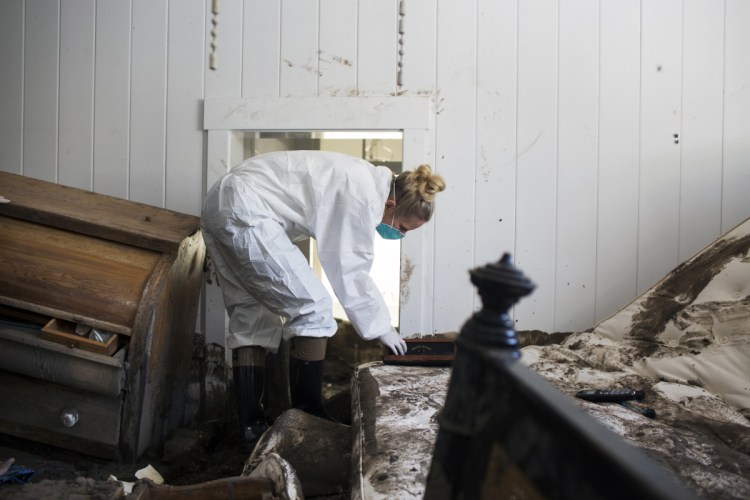MONTECITO, Calif. — When the final mandatory evacuation order lifted after mudslides struck this coastal hillside neighborhood, Dina Landi returned to her home this week anticipating the damage she might find.
Three weeks earlier, she and her partner had fled to a friend’s guesthouse about a mile away, assuming that the voluntary evacuation zone would be safer.
But in the early morning hours of Jan. 9, after they opened the door to check out the rainstorm raging outside, the structure flooded three or four feet deep in seconds, Landi said, forcing the couple to climb onto the guesthouse roof with their 70-pound dog. In the main house, their friend Rebecca Riskin and her husband had been swept away by the mudflow, killing Riskin.
It seemed inevitable that Landi’s house had suffered a similar fate in the mudslides, which destroyed or damaged more than 500 homes. But when she returned, the house was untouched.
“You go through something like this, and you lose somebody – and I don’t mean to sound ungrateful, because I’m really grateful that our house is OK – but you almost don’t care,” she said.
After suffering back-to-back natural disasters, local officials are rethinking how they warn residents about impending threats and designate evacuation zones.
Much of Montecito was evacuated in mid-December when the extensive Thomas Fire blazed on the mountainsides that border the area. The flames left swaths of barren land in their wake, clearing the way for the rain-soaked soil to cascade down toward homes in the foothills.
In the days before the storm struck, Santa Barbara County officials declared a local emergency and issued a mandatory evacuation order for part of Montecito. But only a voluntary evacuation warning was issued for areas between East Valley Road and the Pacific Ocean, farther away from the hillsides.
“Be prepared to leave immediately at your own discretion if the situation worsens,” the county’s notification stated.
County Sheriff Bill Brown said that, in retrospect, the areas officials designated as voluntary evacuation zones were no safer than mandatory ones.
“Obviously, in hindsight, it was not sufficient,” Brown said of the evacuation order. “Had we known what we now know, we would have evacuated the entire area.”
Landi wasn’t alone in her belief that the voluntary evacuation zone was safer.
While many people in both the voluntary and mandatory evacuation zones left the areas, enough stayed to make the mudslides the deadliest disasters in Santa Barbara County’s history, Brown said.
Twenty-one people are confirmed to have died in the mudslides, and two are still missing. People died in both mandatory and voluntary evacuation zones.
“The problem is, sometimes the focus is on the word ‘voluntary,’ rather than the word ‘evacuation,’ ” he said. “The reality is, it’s still an evacuation area.”
County authorities believe “evacuation fatigue” might have led some to stay home during the storms. Everyone asked to leave their homes in anticipation of the Montecito mudslides had been asked to evacuate at least once in December to escape the Thomas Fire, the biggest wildfire in California’s recorded history.
Brown said he also thinks some Montecito residents fell back on their habits for a fire evacuation: Pack a “go bag” and wait to see how close the flames get.
But a mudslide is not a wildfire. It can’t be seen and smelled from miles away.
“We are accustomed, very much so, to fires in Santa Barbara County,” Brown said. “Here, since we haven’t had major flooding for decades, very few people have firsthand knowledge to understand that danger.”
Anticipating the rainstorm, a team of county, state and federal experts had drawn up maps that predicted fairly accurately where the water would fall and the mud would flow, Brown said. The sheriff’s department based its evacuation orders on those maps.
No one wants to trigger widespread panic every time it rains, he added, but the standard procedures used in Montecito did not communicate the true danger to enough residents.
The evacuation orders, both mandatory and voluntary, were covered extensively in the local media for days before the storm hit. On the day the rain started, sheriff’s deputies and other emergency workers went door to door in the mandatory evacuation zones.
Landi and her partner, Geoff Gray, had heard the county’s warnings in the days before the storm, but even as their cellphones blared in the early morning hours, they simply checked the flash-flood alerts and went back to sleep. Being in a voluntary evacuation zone conveyed a sense of security.
It wasn’t until about 3:30 a.m., when they woke to torrential rain, that they opened the door to investigate – allowing a rush of water into the guesthouse.
As they were waiting for rescuers on the roof, Landi and Gray heard Riskin’s husband, Ken Grand, yell out their names.
Landi called 911 for a second time, realizing Grand had been swept from the house and was possibly experiencing hypothermia.
The rescue helicopter came not long after sunrise. Landi and Grand got in, while Gray, Riskin’s adult daughter and the dog were picked up by another helicopter. The next day, Landi and Gray were in the hospital with Grand when they learned that Riskin, a real estate agent, had been killed in the mudslides.
Copy the Story LinkSend questions/comments to the editors.



Success. Please wait for the page to reload. If the page does not reload within 5 seconds, please refresh the page.
Enter your email and password to access comments.
Hi, to comment on stories you must . This profile is in addition to your subscription and website login.
Already have a commenting profile? .
Invalid username/password.
Please check your email to confirm and complete your registration.
Only subscribers are eligible to post comments. Please subscribe or login first for digital access. Here’s why.
Use the form below to reset your password. When you've submitted your account email, we will send an email with a reset code.